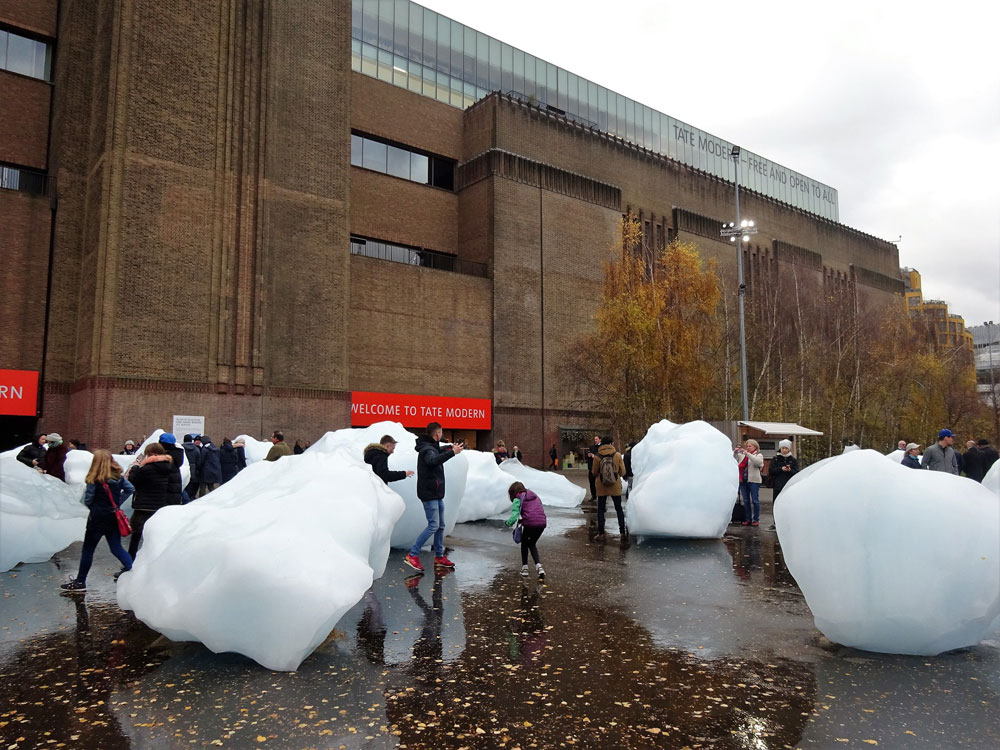
July 17, 2019; ArtNews
The Tate Modern museum has been more responsive than many of its counterparts to the socially conscious demands of its community. It declared earlier this year that it would no longer accept donations from the Sackler family; in 2017, after protests in its galleries, the museum ended its sponsorship deal with the oil giant BP. Now it goes one step further, declaring a climate emergency and expressing commitments to act accordingly.
In a statement on its website, the museum committed to reducing its energy use at least 10 percent by 2023. They also use sustainable, locally sourced food in their restaurants and bars, and are adopting a “travel-first” train policy for staff to cut down on emissions.
All this may seem comparatively small—after all, global emissions have to drop a lot more than ten percent—but the Tate didn’t stop there. They engaged in a reckoning whose example more organizations might want to follow.
The directors wrote:
There are, nevertheless, some hard truths to face about how we operate; about the sustainability of public institutions, like our museums, and about the future of culture. Large public buildings, attracting millions of visitors from the UK and overseas, require energy. We see caring for and sharing a national art collection as a public good, but it also consumes resource. We are rooted in the UK but international in outlook: making art accessible globally depends on the movement of works of art across the world.
That’s why we pledge to make our long-term commitment ambitious in scope. We will interrogate our systems, our values and our programs, and look for ways to become more adaptive and responsible.
That’s not just ordering local tomatoes for salads in the café; that’s reevaluating a mission in light of the crisis that threatens us all. If they’re serious about this commitment, it makes the Tate one of the few large, mainstream organizations to reckon with the climate crisis on its actual scale.
Sign up for our free newsletters
Subscribe to NPQ's newsletters to have our top stories delivered directly to your inbox.
By signing up, you agree to our privacy policy and terms of use, and to receive messages from NPQ and our partners.
This declaration, according to the statement, came out of community debates in Turbine Hall at the museum. As the Tate hosts activist-artist Olafur Eliasson and his climate-focused exhibits, “artists, campaigners, artistic communities and cultural organizations” gathered to discuss the museum’s role in the crisis Eliasson’s work dealt with.
Eliasson told Artnet News that when he began working, “climate change” was expert terminology, and he wants the public to confront the issue.
“I don’t want to use a fear-based narrative, but we are living in a climate emergency,” he said. “A lot of the work deals with the experience of nature, the atmosphere, or ecology, and now these things have been weaponized.”
The Tate has given Eliasson Turbine Hall for a mid-career survey, a nod on their part to the need of museums to be part of living culture.
The museum’s record isn’t perfect, of course. Their partnership with BP caused quite a stir in 2016, and they still have a number of corporate sponsors, including the car manufacturer BMW, at whom activists might look askance.
In a statement to ARTnews, BP or Not BP said, “It’s great to see parts of the art world talking seriously about the climate challenge. But others are still lagging behind…To be actively promoting a fossil fuel company in the middle of a climate crisis is deeply irresponsible, and we hope that Tate’s declaration will make these other institutions think again.”
As museums worldwide scramble to appeal to younger, more diverse, and more conscious audiences, the Tate directors have shown themselves receptive to change where they hear it is needed. That might be the most valuable thing their galleries can show.—Erin Rubin











